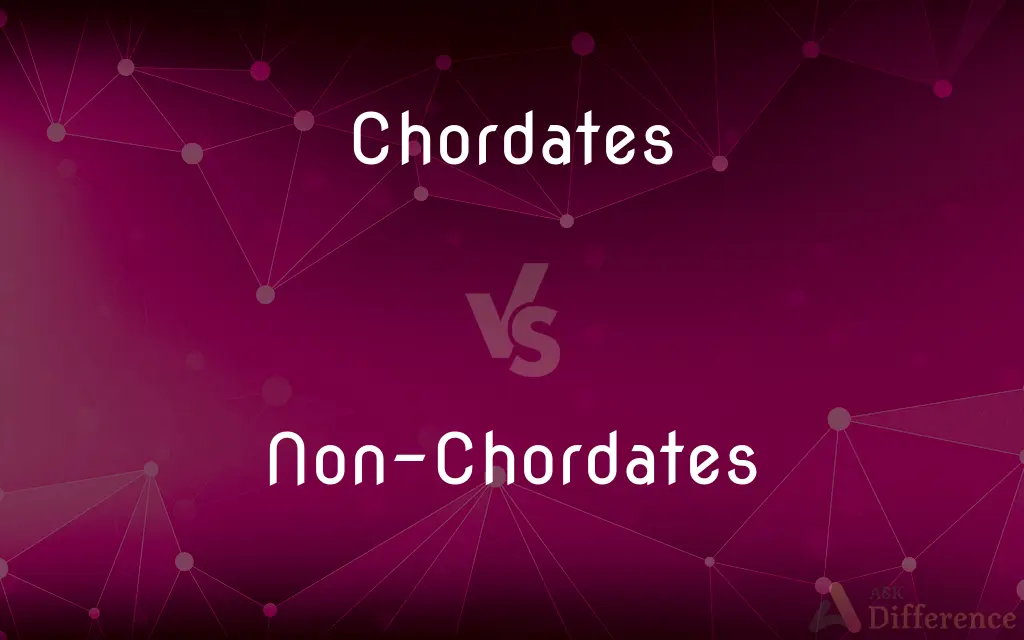Chordates vs. Non-Chordates — What's the Difference?
Edited by Tayyaba Rehman — By Fiza Rafique — Published on January 7, 2024
Chordates have a dorsal, hollow nerve cord and notochord at some life stage; Non-Chordates lack these features.

Difference Between Chordates and Non-Chordates
Table of Contents
ADVERTISEMENT
Key Differences
Chordates are defined by having a notochord, a hollow dorsal nerve cord, pharyngeal slits, and a post-anal tail at some point in their life cycle. Non-Chordates, comprising a vast array of phyla, do not display this suite of characteristics and differ vastly in anatomy and physiology.
Chordates typically have a more complex level of organization, with systems such as a closed circulatory system and an endoskeleton. Non-Chordates can have an open circulatory system, or none at all, and if they have a skeleton, it is often an exoskeleton.
Developmentally, Chordates exhibit deuterostome characteristics, meaning their anus develops from the first opening in the embryo, and the mouth develops later. Non-Chordates, mostly protostomes, have the mouth develop from the first opening, with the anus developing later.
In terms of reproduction, many Chordates engage in internal fertilization and have complex developmental stages, including some form of embryonic development. Non-Chordates often reproduce externally with a variety of reproductive strategies, reflecting their diverse taxa.
Lastly, the Chordate nervous system is centralized and complex, especially in vertebrates. In contrast, Non-Chordate nervous systems can be simple nerve nets, as in cnidarians, or more complex ladder-like systems in higher invertebrates.
ADVERTISEMENT
Comparison Chart
Notochord
Present at some stage
Absent
Nerve Cord
Dorsal and hollow
Varies; often ventral and solid
Skeletal Structure
Endoskeleton often present
Often have an exoskeleton or no skeleton
Development
Deuterostomes
Mostly protostomes
Circulatory System
Closed system
Open or no circulatory system
Compare with Definitions
Chordates
Animals that have pharyngeal slits during embryonic development.
Fish gills are derived from the pharyngeal slits found in all chordates.
Non-Chordates
Species that do not exhibit pharyngeal slits.
Jellyfish, as non-chordates, do not have pharyngeal slits.
Chordates
Animals with a notochord at any life stage.
Sharks are chordates that have a cartilaginous notochord.
Non-Chordates
Animals without a post-anal tail.
Octopuses are non-chordates, lacking a defined post-anal tail.
Chordates
Animals with an internal skeleton.
Humans are chordates with a bony internal skeleton.
Non-Chordates
Animals not belonging to the phylum Chordata.
Snails are non-chordates, part of the Mollusca phylum.
Chordates
Organisms possessing a dorsal nerve cord.
Birds, as chordates, have a complex nervous system.
Non-Chordates
Diverse animals lacking a notochord.
Insects are non-chordates with an exoskeleton instead of a notochord.
Chordates
Members of the phylum Chordata, with a post-anal tail.
The post-anal tail of a tadpole identifies it as a chordate.
Non-Chordates
Organisms without a dorsal, hollow nerve cord.
Worms are non-chordates with a more primitive nervous system.
Chordates
Any of numerous animals of the phylum Chordata, having at some stage of development a dorsal nerve cord, a notochord, and gill slits and including all vertebrates, the hagfishes, and certain marine animals such as the lancelets and the tunicates.
Chordates
Plural of chordate
Common Curiosities
Do non-chordates form a single phylum?
No, non-chordates include multiple phyla with diverse organisms lacking chordate characteristics.
Are humans chordates?
Yes, humans are chordates with a complex skeletal structure and advanced nervous system.
What defines a chordate?
A chordate is an animal that has a notochord, a dorsal nerve cord, pharyngeal slits, and a post-anal tail at some stage.
Can non-chordates have a backbone?
Non-chordates do not have backbones; that feature is exclusive to vertebrates, a subgroup of chordates.
How do chordates differ in reproduction from non-chordates?
Chordates often have internal fertilization, while non-chordates can have a variety of reproductive methods, many external.
What is the significance of the notochord in chordates?
It provides structural support and in vertebrates is replaced by the vertebral column.
Are all chordates vertebrates?
No, not all chordates are vertebrates; some are invertebrates like lancelets and tunicates.
What is an example of a non-chordate?
An example of a non-chordate is an insect like a beetle or a butterfly.
Do all chordates have a notochord throughout their life?
Not all; in many chordates, the notochord is present only during embryonic development.
Can non-chordates be more advanced than some chordates?
"Advanced" is subjective, but some non-chordates exhibit complex behaviors and adaptations.
What kind of circulatory system do non-chordates have?
Non-chordates can have an open circulatory system or no circulatory system at all.
Are chordates always larger than non-chordates?
No, size varies widely; there are small chordates like pygmy shrews and large non-chordates like giant squids.
Do all chordates breathe with gills at some stage?
Many aquatic chordates have gills at some stage, but not all chordates breathe with gills.
Are non-chordate animals found in marine environments?
Yes, many non-chordates are marine, like mollusks and arthropods.
Do chordates always have a more complex nervous system than non-chordates?
Generally yes, especially in vertebrates, but there are complex nervous systems in some non-chordates too.
Share Your Discovery

Previous Comparison
Institutional Traders vs. Retail Traders
Next Comparison
Chime Bank vs. Ally BankAuthor Spotlight
Written by
Fiza RafiqueFiza Rafique is a skilled content writer at AskDifference.com, where she meticulously refines and enhances written pieces. Drawing from her vast editorial expertise, Fiza ensures clarity, accuracy, and precision in every article. Passionate about language, she continually seeks to elevate the quality of content for readers worldwide.
Edited by
Tayyaba RehmanTayyaba Rehman is a distinguished writer, currently serving as a primary contributor to askdifference.com. As a researcher in semantics and etymology, Tayyaba's passion for the complexity of languages and their distinctions has found a perfect home on the platform. Tayyaba delves into the intricacies of language, distinguishing between commonly confused words and phrases, thereby providing clarity for readers worldwide.
















































